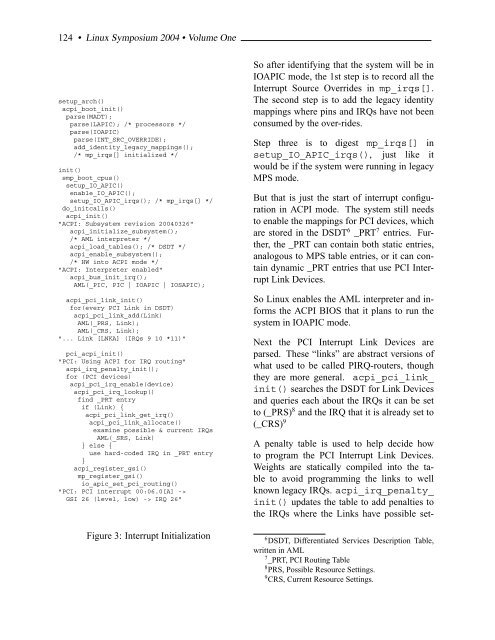You also want an ePaper? Increase the reach of your titles
YUMPU automatically turns print PDFs into web optimized ePapers that Google loves.
124 • <strong>Linux</strong> Symposium 2004 • Volume <strong>One</strong><br />
setup_arch()<br />
acpi_boot_init()<br />
parse(MADT);<br />
parse(LAPIC); /* processors */<br />
parse(IOAPIC)<br />
parse(INT_SRC_OVERRIDE);<br />
add_identity_legacy_mappings();<br />
/* mp_irqs[] initialized */<br />
init()<br />
smp_boot_cpus()<br />
setup_IO_APIC()<br />
enable_IO_APIC();<br />
setup_IO_APIC_irqs(); /* mp_irqs[] */<br />
do_initcalls()<br />
acpi_init()<br />
"ACPI: Subsystem revision 20040326"<br />
acpi_initialize_subsystem();<br />
/* AML interpreter */<br />
acpi_load_tables(); /* DSDT */<br />
acpi_enable_subsystem();<br />
/* HW into ACPI mode */<br />
"ACPI: Interpreter enabled"<br />
acpi_bus_init_irq();<br />
AML(_PIC, PIC | IOAPIC | IOSAPIC);<br />
acpi_pci_link_init()<br />
for(every PCI Link in DSDT)<br />
acpi_pci_link_add(Link)<br />
AML(_PRS, Link);<br />
AML(_CRS, Link);<br />
"... Link [LNKA] (IRQs 9 10 *11)"<br />
pci_acpi_init()<br />
"PCI: Using ACPI for IRQ routing"<br />
acpi_irq_penalty_init();<br />
for (PCI devices)<br />
acpi_pci_irq_enable(device)<br />
acpi_pci_irq_lookup()<br />
find _PRT entry<br />
if (Link) {<br />
acpi_pci_link_get_irq()<br />
acpi_pci_link_allocate()<br />
examine possible & current IRQs<br />
AML(_SRS, Link)<br />
} else {<br />
use hard-coded IRQ in _PRT entry<br />
}<br />
acpi_register_gsi()<br />
mp_register_gsi()<br />
io_apic_set_pci_routing()<br />
"PCI: PCI interrupt 00:06.0[A] -><br />
GSI 26 (level, low) -> IRQ 26"<br />
Figure 3: Interrupt Initialization<br />
So after identifying that the system will be in<br />
IOAPIC mode, the 1st step is to record all the<br />
Interrupt Source Overrides in mp_irqs[].<br />
<strong>The</strong> second step is to add the legacy identity<br />
mappings where pins and IRQs have not been<br />
consumed by the over-rides.<br />
Step three is to digest mp_irqs[] in<br />
setup_IO_APIC_irqs(), just like it<br />
would be if the system were running in legacy<br />
MPS mode.<br />
But that is just the start of interrupt configuration<br />
in ACPI mode. <strong>The</strong> system still needs<br />
to enable the mappings for PCI devices, which<br />
are stored in the DSDT 6 _PRT 7 entries. Further,<br />
the _PRT can contain both static entries,<br />
analogous to MPS table entries, or it can contain<br />
dynamic _PRT entries that use PCI Interrupt<br />
Link Devices.<br />
So <strong>Linux</strong> enables the AML interpreter and informs<br />
the ACPI BIOS that it plans to run the<br />
system in IOAPIC mode.<br />
Next the PCI Interrupt Link Devices are<br />
parsed. <strong>The</strong>se “links” are abstract versions of<br />
what used to be called PIRQ-routers, though<br />
they are more general. acpi_pci_link_<br />
init() searches the DSDT for Link Devices<br />
and queries each about the IRQs it can be set<br />
to (_PRS) 8 and the IRQ that it is already set to<br />
(_CRS) 9<br />
A penalty table is used to help decide how<br />
to program the PCI Interrupt Link Devices.<br />
Weights are statically compiled into the table<br />
to avoid programming the links to well<br />
known legacy IRQs. acpi_irq_penalty_<br />
init() updates the table to add penalties to<br />
the IRQs where the Links have possible set-<br />
6 DSDT, Differentiated Services Description Table,<br />
written in AML<br />
7 _PRT, PCI Routing Table<br />
8 PRS, Possible Resource Settings.<br />
9 CRS, Current Resource Settings.

















